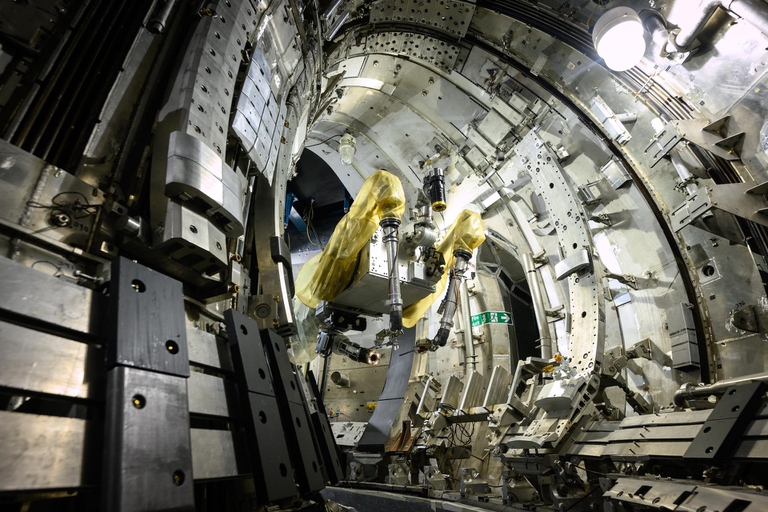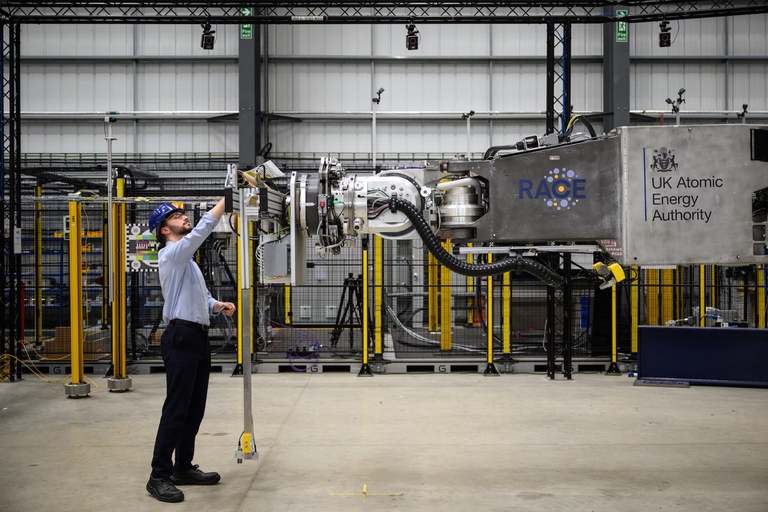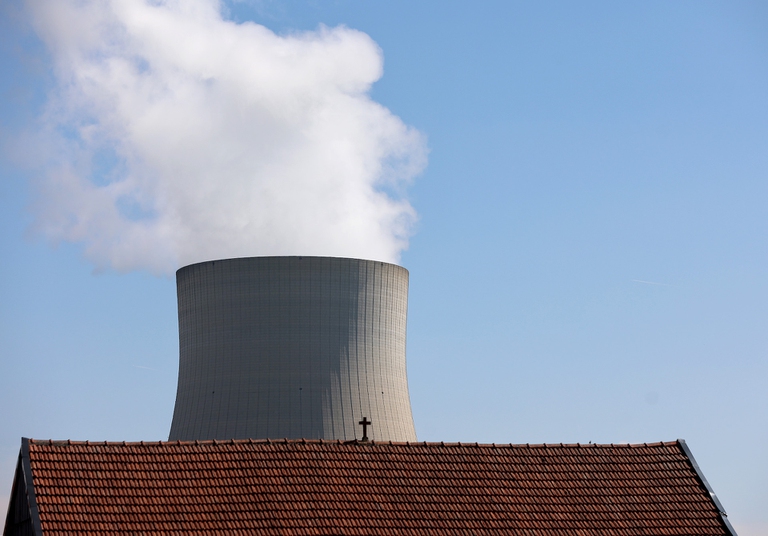https://www.lifegate.it/fusione-nucleare
- |
THE'nuclear energy periodically enters political discourse, as clean, low-emission energy source.Beyond the pros and cons of this technology, for some time now the topic of nuclear fusion.Nuclear fusion is presented as the “clean nuclear” because, unlike the nuclear fission that characterizes today's power plants, it would produce almost unlimited quantities of energy without emissions of harmful gases or greenhouse gases and with the production of limited quantities of radioactive waste including tritium.Particular enthusiasm was generated byexperiment successful at the beginning of 2022, carried out by a European research team in England, the Joint European Torus (Jet) of Oxford, and in which a pulse of nuclear fusion energy lasting at least five seconds was tested, double compared to the previous experiment occurred in 1997.These times just described make it clear how much research is still behind in the development of nuclear fusion technology.Second an old joke, nuclear fusion is that thing that for fifty years has been believed to arrive within thirty years.It is true that controlled nuclear fusion could – in theory – solve energy supply problems on Earth, but it is a technology at the dawn of its evolution, and which therefore alone is not able to solve the problems dictated by climate urgency.
- What is nuclear fusion
- How nuclear fusion works
- History of nuclear fusion, clean nuclear power
- Because nuclear fusion doesn't work yet
- So what about cold fusion?

What is nuclear fusion
Nuclear fusion, by definition, it is a nuclear reaction in which the nuclei of two or more atoms join together forming the nucleus of a new chemical element, more or lessopposite of nuclear fission, reaction at the basis of today's nuclear power plants, where a heavy atom splits into two or more pieces of lower mass.For fusion to be possible it is necessary a large amount of energy, capable of overcoming the electromagnetic repulsion of the nuclei.
This process is at the base of the stars, including the sun, and was first artificially reproduced in the 1950s to amplify the power of the atomic bomb (the so-called H-bomb).Since the 1960s, numerous experiments have been carried out to exploit the energy produced by nuclear fusion, but projects of this type are still under construction.
How nuclear fusion works
As mentioned, nuclear fusion is the chemical-physical reaction at the base of stars in which the hot gas, the plasma, is kept confined and cohesive by their own gravitational force.These are reactions to very high temperatures, therefore the main problem is to find a material capable of keeping the plasma generated during the reaction confined.The most interesting reactions tested so far are those involving the use of deuterium or which exploit the carbon-nitrogen-oxygen cycle.They are reactions that produce temperatures lower than those generated by stars and therefore not yet exploitable for energy purposes.
The most studied reaction for decades, to use fusion in a power plant reactor to produce electricity, is deuterium-tritium fusion, because it is the one that requires the lowest temperature (about 200 million degrees).The disadvantage of this reaction is the production of very high energy, therefore very fast neutrons that cannot be confined by a magnetic field.The neutrons, therefore, interact heavily with the surrounding matter, making the materials used to confine the reaction, such as steel or reinforced concrete, radioactive.Therefore, the activation of these neutrons requires very heavy shielding (e.g. lead).
Some experiments have focused on “aneutronic” reactions, to avoid the creation of fast neutrons.But these projects have to deal with even higher temperatures:there helium 3-deuterium reaction, for example, can produce 580 million degrees.Compared to deuterium-tritium fusion, it would be necessary to increase by 6 times the intensity of the magnetic field, and therefore the confinement capacity, which could be offered by high-temperature superconductor technology.
Inside stars, nuclear fusion is of the type deuterium-deuterium which produces neutrons with a significantly lower energy than the two previous examples, but even higher temperatures.To contain this energy, however, new magnets based on even more advanced high-temperature superconductors are needed, which however are not yet technologically achievable, unless before a few decades.
Although we are talking about very high temperatures, no particular safety problems have been theorized and, according to several experts, if there were they would be less dangerous compared to what could happen in a nuclear fission system whose chain reactions amplify the energy and therefore the heat produced.

History of nuclear fusion, clean nuclear power
The first experiment dates back to 1932 when Mark Oliphant carried out fusion in the laboratory with heavy isotopes of hydrogen.Fusion research for military purposes they began in the early 1940s as part of the Manhattan Project (a research and development program conducted by the United States that led to the creation of atomic bombs) and in 1952 it was used the first H bomb (in jargon Ivy Mike and detonated in the Marshall Islands, in an atoll that still hosts a concrete dome with radioactive waste from nuclear tests underneath).
Over the last sixty years, considerable theoretical and experimental effort has also been made to develop nuclear fusion for civil purposes rather than war or to generate electricity.To date, the most advanced nuclear fusion reactor is represented by Iter (International thermonuclear experimental reactor), toroidal (donut) shaped reactor in which a plasma (usually hydrogen) at very high temperature and low pressure is kept cohesive and away from the internal walls thanks to a magnetic field generated by electromagnets external to the chamber.
The Iter project involves 35 nations (including the member states of the European Union, the United States, India, Japan, South Korea and Russia) with the aim of building the first experimental reactor of this like in Cadarache, in the south of France. Italy participates in Iter with a testing site in Frascati.
In addition to Iter, there are two other experimental projects, Sparc (of which Eni is the largest shareholder) and Arc. The first demonstration reactor, the project Demos, if everything goes according to plan and in strong discontinuity compared to past delays, it could be ready not before 2050. Demo is in fact a prototype reactor for a nuclear fusion power plant studied by the European Eurofusion consortium as the ideal successor to the experimental Iter reactor.
Because nuclear fusion doesn't work yet
The main problem from the 1960s to now, and probably also for the foreseeable future, is represented by difficulty achieving a positive energy balance of the reactor.To date, in fact, it has not yet been possible to build a reactor that produces normally during its continuous operation more electricity than you consume to power the magnets and auxiliary containment systems.
Not a minor problem it's about costs:Iter, the most advanced project on nuclear fusion, initially expected a cost of 13 billion euros but there are those who claim that it could easily reach 30 billion, not to mention the need to use an enormous amount of energy to be able to continue with the experiments.

So what about cold fusion?
On March 23, 1989, at the University of Utah, the two electrochemists Martin Fleischmann and Stanley Pons declared in a press conference of having achieved nuclear fusion not in a very hot plasma maintained at extreme pressures inside enormous and complex reactors, but “in a test tube”, at room temperature.The two scientists inaugurated the season of "cold fusion", which promised to revolutionize the world of energy.As we know, the revolution never came.Why?
First, one battle to obtain the patent before others, led to research never being fully studied so that it could be replicated.The haste with which the results were published by Fleschmann and Pons did not allow various anomalies that appeared in the design phase to be resolved.For this, cold fusion it was never proven by the scientific community nor did a commercial prototype ever arrive.
In conclusion, nuclear fusion is certainly a very fascinating technology with rich potential.But there are still many problems along its evolutionary path and given the ongoing climate emergency, its Development times are still too slow and expensive in order to represent a valid solution for the energy sector.
